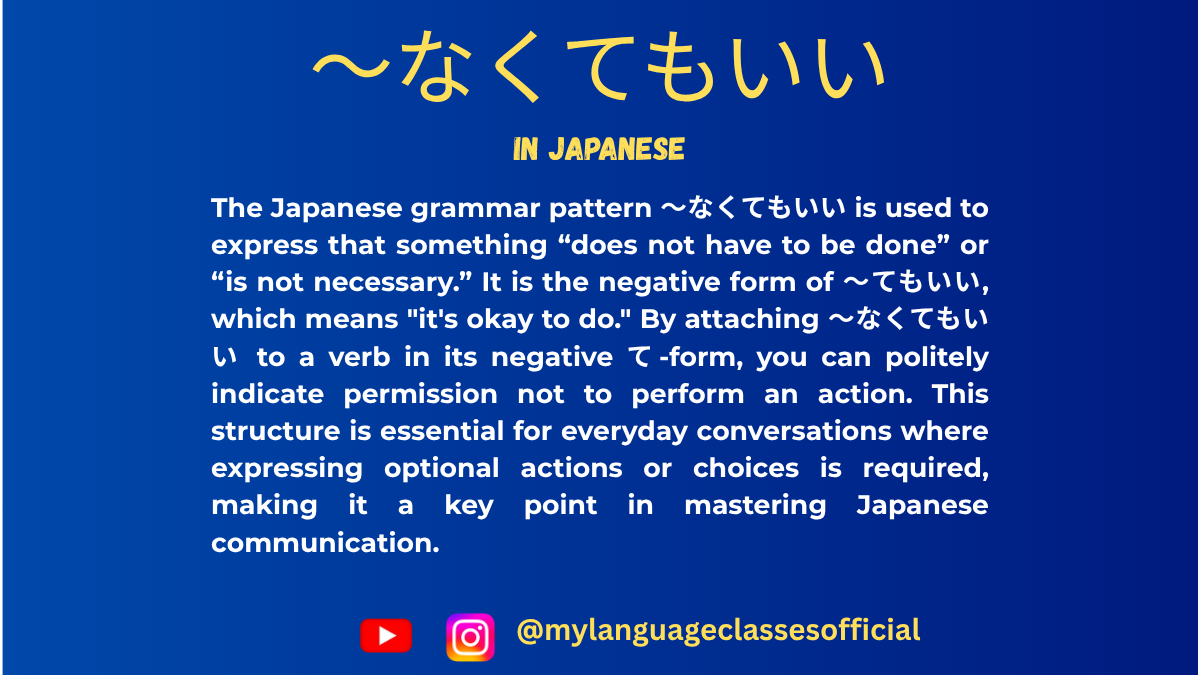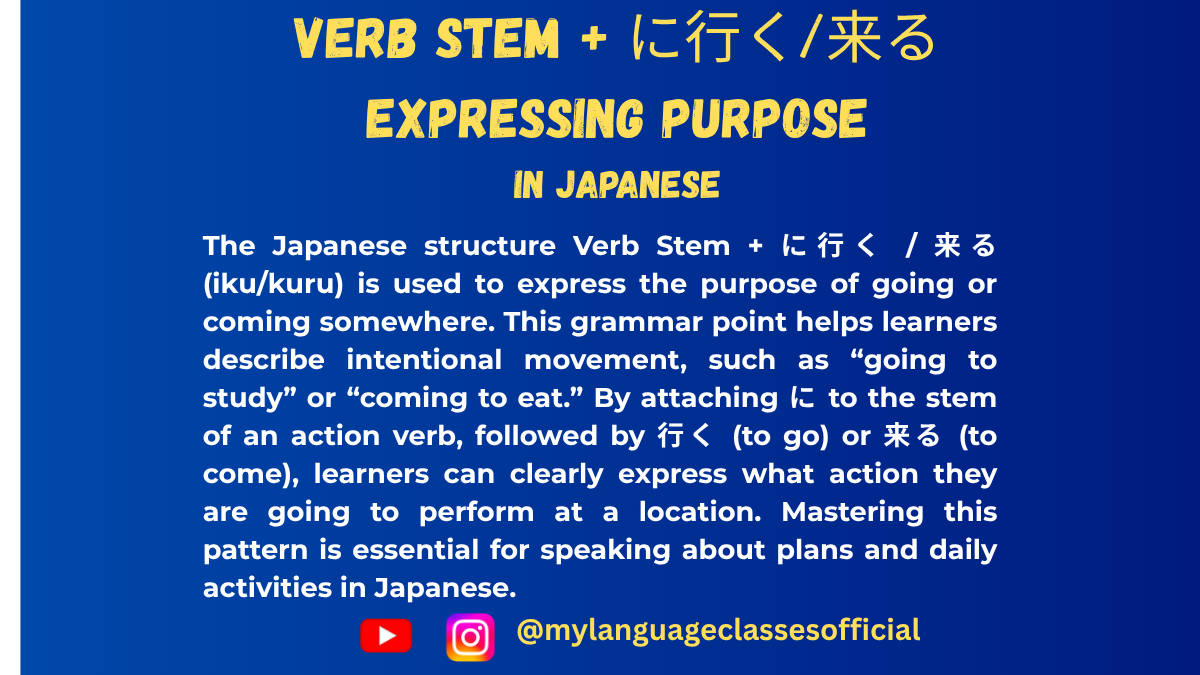Your cart is currently empty!
Tag: Japanese grammar
-
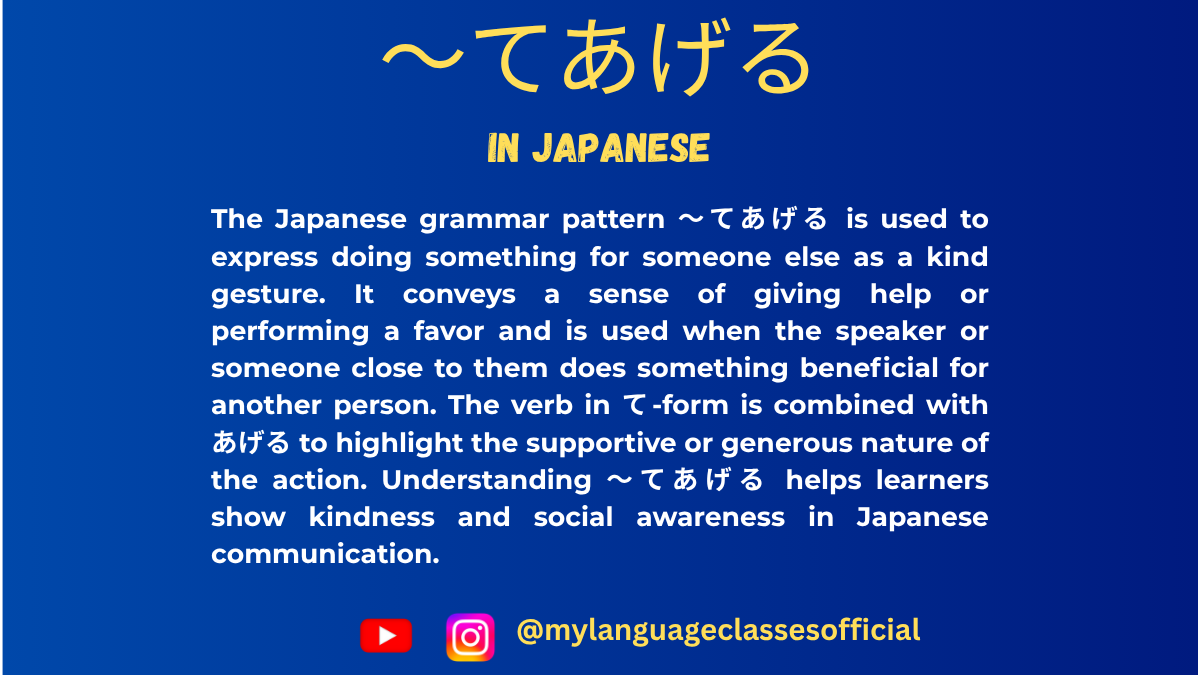
How to Use 〜てあげる | My Language Classes
〜てあげる: To Give (an Action) in Japanese
When learning Japanese, you will often encounter the phrase 〜てあげる (te ageru), which means “to give (an action).” This phrase is used when the speaker or someone performs a beneficial action for another person. The nuance of 〜てあげる is that the action is done out of kindness or generosity.
How to Use 〜てあげる
The structure is simple:
[Person] は [Recipient] に [Action in 〜て-form] + あげる
Example:
- わたしは ともだち に 本を 貸してあげました。
(Watashi wa tomodachi ni hon o kashite agemashita.)
→ I lent a book to my friend (as a favor).
Different Forms of 〜てあげる
The verb あげる can be conjugated into different forms to match the politeness level:
Form Usage 〜てあげる Casual/plain form 〜てあげます Polite form 〜てあげて Te-form for requests 〜てあげない Negative form (not doing the action) 〜てあげなかった Past negative form Situations Where 〜てあげる Is Used
1. Doing Something Nice for Someone Else
- わたしは ちょうとせんせい に にもつを 持ってあげました。
(Watashi wa chouto sensei ni nimotsu o motte agemashita.)
→ I carried the teacher’s luggage for them.
2. Helping Someone
- おとうさんは ぼくに 自転車の修理を してあげた。
(Otousan wa boku ni jitensha no shuuri o shite ageta.)
→ Dad fixed my bicycle for me.
3. Giving Advice or Instruction
- わたしは ともだち に 日本語 を 教えてあげる。
(Watashi wa tomodachi ni nihongo o oshiete ageru.)
→ I will teach my friend Japanese.
4. Buying Something for Someone
- おかあさんは いもうと に 花を 買ってあげました。
(Okaasan wa imouto ni hana o katte agemashita.)
→ Mom bought flowers for my little sister.
5. Making a Favorable Gesture
- 私は 友達 に コーヒーを 作ってあげました。
(Watashi wa tomodachi ni koohii o tsukutte agemashita.)
→ I made coffee for my friend.
6. Expressing Kindness in a Relationship
- けんたろうは かのじょに マッサージを かいてあげた。
(Kentaro wa kanojo ni massaaji o kaite ageta.)
→ Kentaro gave his girlfriend a massage.
7. Helping Children or Animals
- おねえさんは 犬 に 食べ物 を あげてあげた。
(Oneesan wa inu ni tabemono o agete ageta.)
→ The older sister gave food to the dog.
Things to Remember About 〜てあげる
- Used when the action is beneficial: You should only use 〜てあげる when the action is helpful or kind.
- Do not use for superiors: Avoid using 〜てあげる when speaking about actions for a superior (e.g., boss, teacher) as it may sound rude. Instead, use 〜てさしあげる.
- Casual tone: This phrase is often used in informal or everyday conversations rather than in formal writing.
Summary Table: When to Use 〜てあげる
Situation Example Helping a friend はさみを 買ってあげた。 (Bought scissors for them.) Teaching someone えいご を 教えてあげる。 (Teach English to them.) Doing a favor 部屋を 掃除してあげる。 (Clean the room for them.) Helping animals 犬 に 飯 を あげてあげる。 (Give food to a dog.) By mastering 〜てあげる, you can express kindness and generosity in Japanese naturally! Practice using it in real conversations to make your speech sound more fluent and native-like.
Do you have any questions about 〜てあげる? Let me know in the comments!
If you enjoyed this lesson, be sure to check out more posts like this on my blog at My Language Classes. Don’t forget to subscribe my YouTube channel and follow me on Instagram for the latest language learning tips and lessons. Leave a comment below to share your thoughts, or ask any questions you have about nouns.
Happy learning! 😊
- わたしは ともだち に 本を 貸してあげました。
-
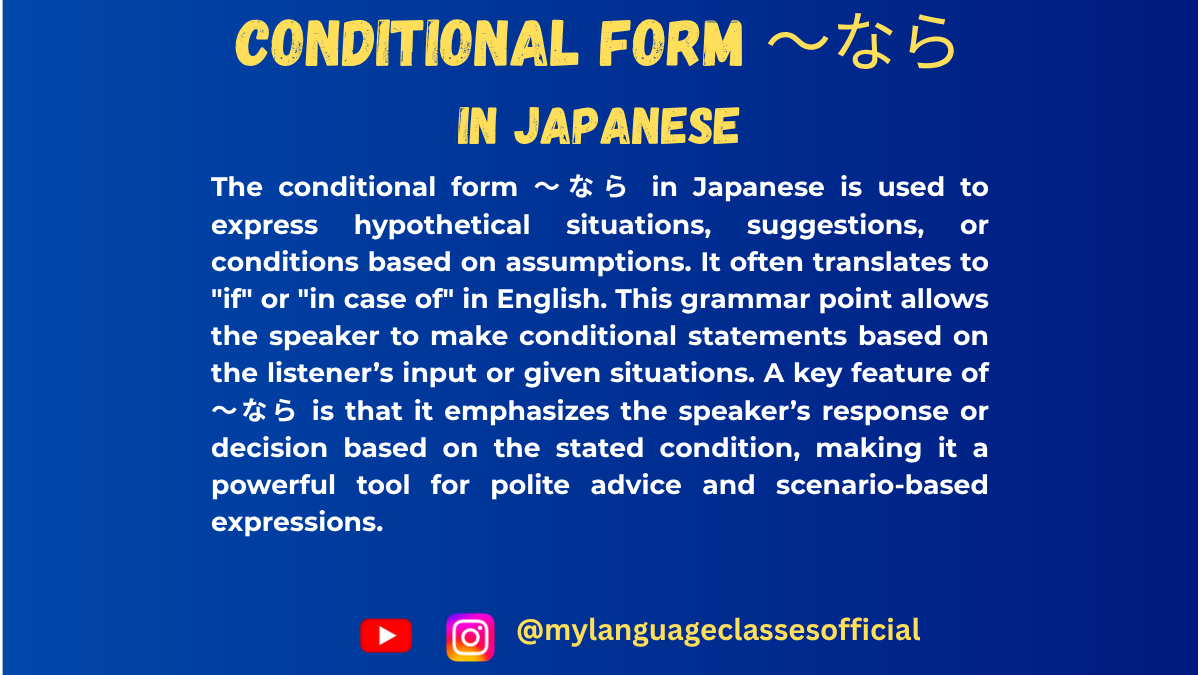
Using 〜なら for hypothetical situations | My Language Classes
〜なら: Expressing “If” or “As for” in Japanese
In Japanese, 〜なら is a versatile grammar structure often used to express conditionality (“if”) or to provide contextual emphasis (“as for”). This blog post will explore its usage in various contexts and provide a comprehensive list of situations where 〜なら is applicable.
What is 〜なら?
The particle なら is derived from the verb 成る (なる), which means “to become.” In grammar, it functions as a conditional marker or a topic-related particle depending on the context. It is commonly attached to the plain form of verbs, nouns, or adjectives.
Usage of 〜なら
1. Conditional “If”
- Meaning: Expresses a hypothetical or conditional situation.
- Structure:
Clause A (plain form) + なら, Clause B
Clause B often represents the speaker’s judgment, advice, or consequence.
Examples:
- 日本に行くなら、富士山を見たほうがいいですよ。
(Nihon ni iku nara, Fujisan o mita hō ga ii desu yo.)
If you’re going to Japan, you should see Mt. Fuji. - 雨が降るなら、外出しないほうがいいです。
(Ame ga furu nara, gaishutsu shinai hō ga ii desu.)
If it rains, you shouldn’t go out.
2. Topic-Based “As for”
- Meaning: Indicates that a specific topic is being addressed in response to a preceding statement or question.
- Structure:
Noun + なら
Examples:
- 映画なら、コメディが一番好きです。
(Eiga nara, komedi ga ichiban suki desu.)
As for movies, I like comedies the best. - この本なら、もう読んだことがあります。
(Kono hon nara, mō yonda koto ga arimasu.)
As for this book, I’ve already read it.
3. Contrasting Ideas
- Meaning: Suggests a contrast between two different ideas or topics.
- Structure:
Noun/Adjective/Verb + なら
Examples:
- 英語なら話せますが、フランス語は話せません。
(Eigo nara hanasemasu ga, Furansugo wa hanasemasen.)
If it’s English, I can speak it, but I can’t speak French. - 安いなら買いますが、高いなら買いません。
(Yasui nara kaimasu ga, takai nara kaimasen.)
If it’s cheap, I’ll buy it, but if it’s expensive, I won’t.
4. Hypothetical Suggestions
- Meaning: Used when giving suggestions or advice based on hypothetical conditions.
- Structure:
Clause + なら
Examples:
- 東京に行くなら、スカイツリーを訪れるべきです。
(Tōkyō ni iku nara, Sukaitsurī o otozureru beki desu.)
If you’re visiting Tokyo, you should check out the Skytree. - 勉強するなら、早めに始めたほうがいいですよ。
(Benkyō suru nara, hayame ni hajimeta hō ga ii desu yo.)
If you’re going to study, it’s better to start early.
5. Clarifications or Conditions
- Meaning: Used when responding to a condition or clarifying information.
- Structure:
Noun + なら
Examples:
- 山田さんなら、もう帰りましたよ。
(Yamada-san nara, mō kaerimashita yo.)
If you’re talking about Yamada-san, he’s already gone home. - 駅なら、この道をまっすぐ行けば着きます。
(Eki nara, kono michi o massugu ikeba tsukimasu.)
If you mean the station, go straight down this road.
When to Use 〜なら?
Here is a quick checklist of situations where 〜なら is appropriate:
- Making a Hypothetical Conditional Statement:
“If you’re going to X, then Y.” - Responding to Questions or Comments with Context:
“As for X, Y applies.” - Contrasting Two Scenarios or Topics:
“If X is true, Y. But if not, Z.” - Providing Advice Based on Hypothetical Situations:
“If you’re considering X, then Y is a good idea.” - Clarifying or Confirming a Specific Topic:
“If you’re talking about X, then Y.”
Tips for Using 〜なら
- Be Contextual: 〜なら thrives on context. Make sure the listener understands the implied condition or topic.
- Be Specific: Use it to address clear contrasts or hypothetical situations, avoiding vague statements.
- Practice Intonation: When using 〜なら in spoken Japanese, emphasize the conditional tone to make your intent clear.
By mastering 〜なら, you’ll find yourself able to express conditions, offer advice, and clarify topics more effectively in Japanese. Practice by creating your own sentences in real-life scenarios!
If you enjoyed this lesson, be sure to check out more posts like this on my blog at My Language Classes. Don’t forget to subscribe my YouTube channel and follow me on Instagram for the latest language learning tips and lessons. Leave a comment below to share your thoughts, or ask any questions you have about nouns.
Happy learning! 😊
-

Understanding 〜みたい in Japanese | My Language Classes
Expressing Resemblance and Conjecture in Japanese:〜みたい
When learning Japanese, understanding the nuanced use of grammatical structures can significantly improve your fluency. One such structure is 〜みたい. This versatile expression is commonly used in both casual and formal conversations to convey resemblance or conjecture. Let’s delve into the various ways 〜みたい is used and provide examples to solidify your understanding.
What is 〜みたい?
〜みたい is a colloquial expression that can be roughly translated as “like,” “seems like,” or “looks like.” It functions similarly to the formal grammatical structures 〜ようだ and 〜そうだ, but it is often used in casual speech.
Usage of 〜みたい
1. To Express Resemblance or Similarity
When you want to say something is similar to or resembles something else, you use 〜みたい after a noun.
- Structure:
Noun + みたい - Examples:
- 子供みたいに遊んでいる。
(Playing like a child.) - 雲が綿菓子みたいだ。
(The clouds look like cotton candy.)
- 子供みたいに遊んでいる。
2. To Indicate Conjecture Based on Observation
When you infer or guess something based on what you see, hear, or feel, 〜みたい can be used.
- Structure:
Verb (plain form) + みたい
Noun + みたい
Adjective (plain form) + みたい - Examples:
- 雨が降ったみたいだ。
(It seems like it rained.) - 彼は疲れているみたい。
(He seems tired.) - このケーキ、美味しいみたいだね。
(This cake seems delicious.)
- 雨が降ったみたいだ。
3. To Describe Hypothetical Situations or Figurative Comparisons
You can use 〜みたい to express something as if it were true, even though it isn’t.
- Structure:
Verb (plain form) + みたい
Noun + みたい - Examples:
- 夢みたいな話だ。
(It’s like a dream.) - あの二人は本当の兄弟みたいだ。
(Those two are like real brothers.)
- 夢みたいな話だ。
4. To Indicate Behavior or Action Similarity
You can describe someone acting like something or someone else using 〜みたい.
- Structure:
Verb (plain form) + みたい
Noun + みたい - Examples:
- 彼は猫みたいに静かに歩く。
(He walks quietly like a cat.) - 泣いているみたいに見える。
(It looks like they’re crying.)
- 彼は猫みたいに静かに歩く。
5. To Express Uncertainty or Doubt
When you are unsure about a situation, you can use 〜みたい to express your uncertainty.
- Structure:
Verb (plain form) + みたい
Noun + みたい - Examples:
- あの店、閉まっているみたいだ。
(It looks like that shop is closed.) - 試験は簡単みたいだけど、本当はどうかな?
(The test seems easy, but I wonder if it really is?)
- あの店、閉まっているみたいだ。
List of Situations Where 〜みたい is Used
- Comparing one object/person to another.
- Example: 彼女はお姫様みたいだ。 (She looks like a princess.)
- Guessing or making conjectures based on evidence.
- Example: 外は寒いみたいだ。 (It seems cold outside.)
- Making figurative or hypothetical comparisons.
- Example: 今日は地獄みたいに暑い。 (Today is as hot as hell.)
- Describing someone’s behavior or appearance.
- Example: 彼は大人みたいに振る舞う。 (He behaves like an adult.)
- Expressing uncertainty or hesitation.
- Example: あの人は誰か知っているみたいだけど、自信はない。 (It seems like they know that person, but I’m not sure.)
Key Points to Remember
- Casual Nature: 〜みたい is commonly used in informal settings. For more formal contexts, consider using 〜ようだ.
- Interchangeability: In some cases, 〜みたい, 〜ようだ, and 〜そうだ can be used interchangeably, but the nuance may differ slightly.
- Flexibility: It can follow nouns, verbs, and adjectives, making it highly versatile.
Practice Exercises
Try constructing sentences using 〜みたい for the following scenarios:
- Describe a situation where something resembles something else.
- Make a conjecture about something you just observed.
- Create a figurative comparison about an extreme weather condition.
By mastering 〜みたい, you’ll enhance your ability to express nuanced thoughts and interpretations in Japanese. Keep practicing, and soon it will become second nature in your conversations!
If you enjoyed this lesson, be sure to check out more posts like this on my blog at My Language Classes. Don’t forget to subscribe my YouTube channel and follow me on Instagram for the latest language learning tips and lessons. Leave a comment below to share your thoughts, or ask any questions you have about nouns.
Happy learning! 😊
- Structure:
-
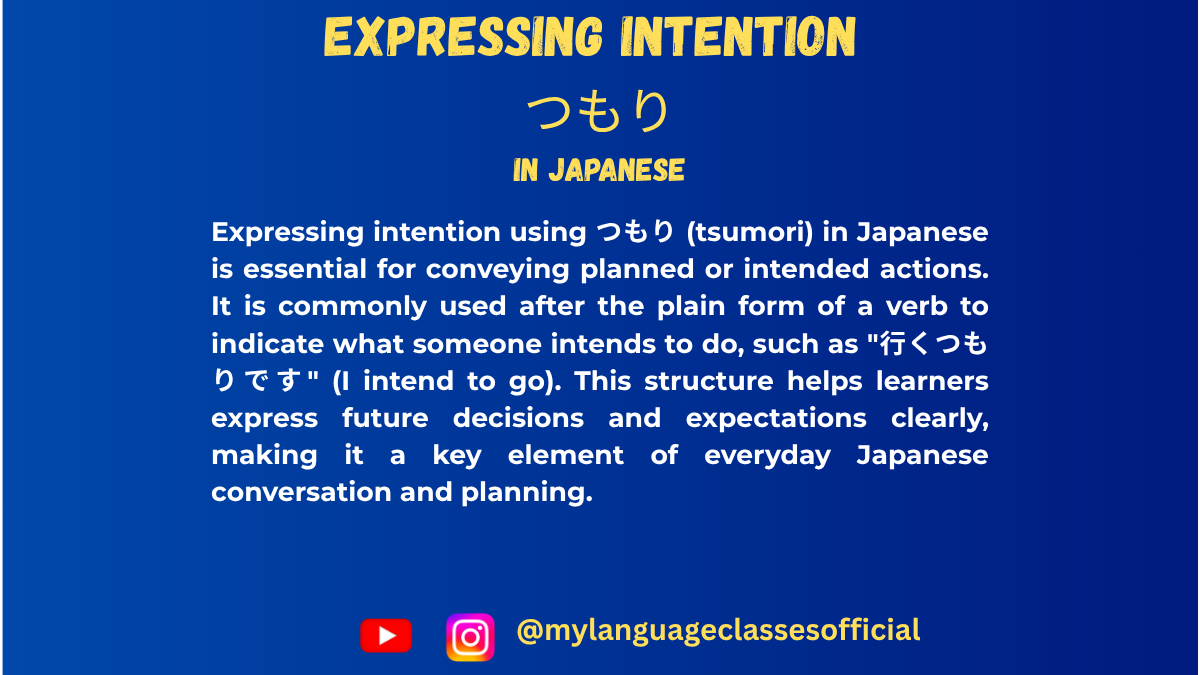
Expressing Intention in Japanese:つもり| My Language Classes
How to Show Intention in Japanese
When learning Japanese, understanding how to articulate intentions or plans is crucial. One of the most common and versatile expressions for this purpose is 〜つもり (tsumori). This post explores the usage of 〜つもり, its nuances, and the various situations where it can be employed.
What is 〜つもり?
〜つもり is a grammatical structure used to express one’s intention, determination, or a plan to do something. It can also convey assumptions or beliefs in certain contexts. The term “tsumori” itself translates to “intention” or “plan.”
The construction is relatively simple:
[Verb in dictionary form] + つもりです – Intend to do something.
[Verb in nai-form] + つもりです – Intend not to do something.
How to Use 〜つもり?
1. Expressing Future Intentions
You can use 〜つもり to clearly state your plans for the future:
- 私は明日学校に行くつもりです。 – I intend to go to school tomorrow.
- 私は歌をうたわないつもりです。 – I intend not to sing a song.
2. Talking About Assumptions
〜つもり can also indicate a belief or assumption about a situation, often with an implied contrast to reality:
- 私は深く理解しているつもりでした。しかし…。 – I thought I understood it deeply, but…
This usage typically involves a past-tense verb and often reflects a misunderstanding.
3. Expressing Unintentional Actions
Although rare, 〜つもり is used to deny responsibility when you didn’t intentionally perform an action:
- それを言うつもりはなかった。 – I didn’t mean to say that.
Politeness Levels
〜つもりです is a polite expression suitable for formal and semi-formal settings. In casual conversations, you can drop です:
- 明日行くつもり。 – I plan to go tomorrow.
Adding 「つもりだよ」 or 「つもりだけど」 softens the tone even further.
Key Situations for Using 〜つもり
Here’s a comprehensive list of contexts where 〜つもり is commonly used:
- Future Plans:
- 私は明日山に行くつもりです。 – I intend to go to the mountains tomorrow.
- Negating Intentions:
- 今年は流行の服を買わないつもりです。 – I don’t plan to buy trendy clothes this year.
- Explaining Changes in Plans:
- 行くつもりだったけど、天気が悪くなりました。 – I intended to go, but the weather turned bad.
- Making Assumptions:
- 自分は結婚しないつもりでしたが…。 – I assumed I wouldn’t get married, but…
- Unintentional Actions:
- あなたを傷つけるつもりはありません。 – I didn’t intend to hurt you.
- Future Determination:
- もっと勉強するつもりです。 – I am determined to study harder.
Common Mistakes to Avoid
- Misinterpreting 〜つもり as a Promise: While 〜つもり expresses intention, it doesn’t guarantee that the action will happen. Avoid confusing it with words like やくそく (yakusoku – promise).
- Using 〜つもり in Commands or Requests: 〜つもり cannot be used to make requests or issue commands.
- Overusing in Formal Writing: In highly formal contexts, more precise expressions like 計画しています (“I am planning”) may be more appropriate.
Practice Examples
Try constructing sentences using 〜つもり in different situations. For instance:
- 私は今年日本語を終わらせるつもりです。
- 私はその話を聞いたつもりですが…
By practicing various scenarios, you’ll gain confidence in using this versatile expression.
Understanding 〜つもり is a valuable step in mastering Japanese. It allows you to articulate intentions, beliefs, and assumptions effectively. Whether planning a trip, expressing a future goal, or clarifying misunderstandings, this structure adds depth to your language skills. Happy studying!
If you enjoyed this lesson, be sure to check out more posts like this on my blog at My Language Classes. Don’t forget to subscribe my YouTube channel and follow me on Instagram for the latest language learning tips and lessons. Leave a comment below to share your thoughts, or ask any questions you have about nouns.
Happy learning! 😊
-

Understanding 〜でしょう/だろう in Japanese | My Language Classes
Expressions used to indicate probability, conjecture, or seeking confirmation
If you’re diving into the world of Japanese grammar, the particle でしょう (deshou) is one you’ll encounter frequently. It’s a versatile expression that conveys probability, speculation, or seeks confirmation. In this blog post, we’ll explore all the nuances of でしょう, its various uses, and how it interacts with other elements of the language.
1. What is でしょう?
でしょう is the polite form of だろう, which itself is derived from the copula だ (used to state facts). Depending on the context and tone, it can mean:
- “Probably”
- “I suppose”
- “Right?” (as a tag question seeking agreement)
- “It seems that”
Forming でしょう
- Nouns/Na-adjectives:
Add でしょう after the plain form.
Example:
学生 でしょう。 (It’s probably a student.) - I-adjectives:
Attach directly to the base form.
Example:
暑い でしょう。 (It’s probably hot.) - Verbs:
Attach to the plain form.
Example:
行く でしょう。 (He/she/they will probably go.)
2. Expressing Probability
One of the most common uses of でしょう is to express probability or likelihood. It’s often used when the speaker wants to indicate that something is likely true based on their knowledge or perception.
Examples:
- 明日は雨が降る でしょう。
(It will probably rain tomorrow.) - あの映画は面白い でしょう。
(That movie is probably interesting.)
In these cases, でしょう is equivalent to saying “probably” or “I think” in English. It softens the statement, showing that the speaker is not asserting something as a definite fact.
3. Asking for Confirmation
When used with a rising intonation, でしょう turns into a tag question, seeking agreement or confirmation from the listener. It can be translated as “right?” or “isn’t it?” in English.
Examples:
- このケーキ、美味しい でしょう?
(This cake is delicious, isn’t it?) - 彼は先生 でしょう?
(He’s a teacher, right?)
The rising tone at the end signals the speaker is looking for confirmation or agreement.
4. Making Guesses or Predictions
You’ll often hear でしょう in weather forecasts, news reports, or any context where predictions are made.
Examples:
- 明日の天気は晴れ でしょう。
(Tomorrow’s weather will probably be sunny.) - この問題は簡単 でしょう。
(This problem is probably easy.)
In such cases, the speaker uses でしょう to make a statement that isn’t 100% certain but is backed by reasonable evidence or context.
5. でしょう in Casual Speech: だろう
In informal situations, だろう is often used instead of でしょう, especially by men. While だろう serves the same functions, it feels less polite and more casual.
Examples:
- あれは本物のダイヤモンド だろう。
(That’s probably a real diamond.) - 今日は忙しい だろう?
(You’re busy today, right?)
6. Negative Forms
The negative equivalent of でしょう is formed by negating the predicate or verb.
Examples:
- あのレストランは高くない でしょう。
(That restaurant is probably not expensive.) - 彼は来ない でしょう。
(He probably won’t come.)
7. Using でしょう in Hypothetical or Conditional Contexts
When paired with the conditional たら or similar structures, でしょう can express speculation about hypothetical situations.
Examples:
- あの店に行ったら、何か美味しいものがある でしょう。
(If we go to that store, there will probably be something delicious.) - もっと勉強したら、試験に合格する でしょう。
(If you study more, you will probably pass the exam.)
8. Cultural Nuances and Subtleties
In Japanese communication, でしょう plays a role in maintaining politeness and avoiding direct assertions. By using でしょう, the speaker softens their statements, allowing room for the listener’s interpretation or input. This aligns with Japanese cultural norms that emphasize indirectness and respect for others’ perspectives.
For example:
- 今日は寒いです。 (It’s cold today.)
→ Direct and factual. - 今日は寒いでしょう。 (It’s probably cold today.)
→ Politer, leaving room for the listener’s agreement or alternative opinion.
9. Common Pitfalls and Misunderstandings
- でしょう vs かもしれない:
Both express uncertainty, but かもしれない conveys a lower degree of certainty compared to でしょう.
Example:
彼は来る でしょう。 (He will probably come.)
彼は来る かもしれない。 (He might come.) - Overuse in Confirmation Questions:
While でしょう is great for seeking agreement, overusing it can make your speech sound repetitive. Balance it with other expressions like よね or ね for variety.
10. Final Notes
Mastering でしょう allows you to add nuance to your Japanese and navigate conversations more smoothly. It’s a fantastic tool for expressing uncertainty politely, making predictions, or asking for confirmation. Remember:
- Use でしょう for polite speech and だろう for casual contexts.
- Pay attention to intonation when seeking confirmation.
- Practice with real-life scenarios to internalize its subtleties.
Do you have any questions about でしょう or other Japanese grammar points? Share them in the comments below, and let’s learn together! 😊
If you enjoyed this lesson, be sure to check out more posts like this on my blog at My Language Classes. Don’t forget to subscribe my YouTube channel and follow me on Instagram for the latest language learning tips and lessons. Leave a comment below to share your thoughts, or ask any questions you have about nouns.
Happy learning! 😊
-
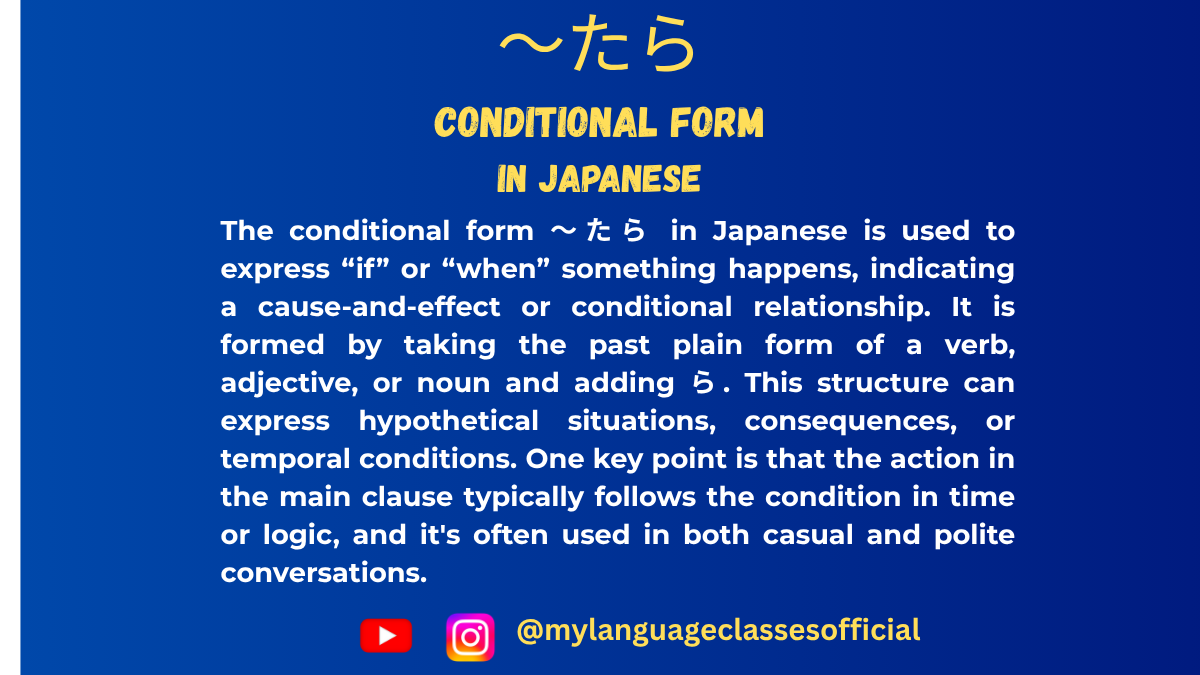
Understanding Conditional form ~たら in Japanese | My Language Classes
Understanding ~たら in Japanese
Learning Japanese grammar often feels like solving a puzzle, where each piece contributes to your fluency. One such critical piece is the ~たら structure, a conditional form that translates roughly to “if” or “when” in English. In this blog post, we’ll break down how to use ~たら effectively, covering its structure, usage, and nuances, along with examples to boost your confidence.
What is ~たら?
The ~たら structure comes from the past tense form of a verb, adjective, or noun, combined with ら (ra). It’s used to express conditional situations, which means it helps us talk about “if” or “when” something happens.
Key Functions of ~たら:
- Expressing Conditions: “If X happens, then Y will occur.”
- Temporal Sense: “When X happens, Y will follow.”
This dual meaning is a hallmark of ~たら, and context determines whether it means “if” or “when.”
The Structure of ~たら
Let’s look at how to form ~たら for different word types:
1. Verbs
- Take the plain past tense form (た-form) of the verb + ら.
- Example:
食べる → 食べた → 食べたら (if/when [I] eat)
2. Adjectives
- For い-adjectives, replace the final い with かったら.
- Example: 高い → 高かった → 高かったら (if/when [it’s] expensive)
- For な-adjectives, use the structure: adjective + だったら.
- Example: 静か → 静かだったら (if/when [it’s] quiet)
3. Nouns
- Combine the noun with だったら.
- Example: 休み → 休みだったら (if/when [it’s] a holiday)
Usage Examples
Let’s explore ~たら in action, both as “if” and “when.”
1. Conditional “If”
- 日本に行ったら、寿司を食べたいです。
(Nihon ni ittara, sushi o tabetai desu.)
If I go to Japan, I want to eat sushi. - 時間があったら、映画を見ましょう。
(Jikan ga attara, eiga o mimashou.)
If we have time, let’s watch a movie.
Here, the meaning hinges on a hypothetical condition being met.
2. Temporal “When”
- 家に帰ったら、宿題をします。
(Ie ni kaettara, shukudai o shimasu.)
When I get home, I’ll do my homework. - 雨がやんだら、公園で遊びましょう。
(Ame ga yandara, kouen de asobimashou.)
When the rain stops, let’s play at the park.
In these examples, ~たら conveys a temporal relationship, emphasizing a sequence of events.
Nuances and Tips
- Avoid Overlapping ~たら with ~と or ~ば
While ~と and ~ば also express conditions, ~たら is more versatile because it handles both “if” and “when.” However, ~と is more deterministic (e.g., water boils when heated), and ~ば can feel more formal or speculative. - Expressing Surprise or Discovery
~たら is also used to convey unexpected results:- ドアを開けたら、猫がいました。
(Doa o aketara, neko ga imashita.)
When I opened the door, there was a cat.
Here, the speaker did not anticipate finding a cat.
- ドアを開けたら、猫がいました。
- Avoid Using ~たら for Certainties
If an event is guaranteed to occur (e.g., the sun rising), use a temporal marker like ~時 instead of ~たら.
Practice Time!
Try making your own sentences using ~たら. Here are some prompts to get you started:
- What would you do if you won the lottery?
宝くじに当たったら、______。 - What will you do when the weekend comes?
週末になったら、______。
Share your answers in the comments or with your language partner. Practice makes perfect!
Final Thoughts
The ~たら structure is a cornerstone of Japanese conditional grammar. By mastering it, you’ll unlock the ability to express complex ideas about possibilities and sequences. Remember to pay attention to context to distinguish between “if” and “when,” and don’t hesitate to experiment with it in your conversations.
Ready to elevate your Japanese skills? Try using ~たら today!
If you enjoyed this lesson, be sure to check out more posts like this on my blog at My Language Classes. Don’t forget to subscribe my YouTube channel and follow me on Instagram for the latest language learning tips and lessons. Leave a comment below to share your thoughts, or ask any questions you have about nouns.
Happy learning! 😊
-
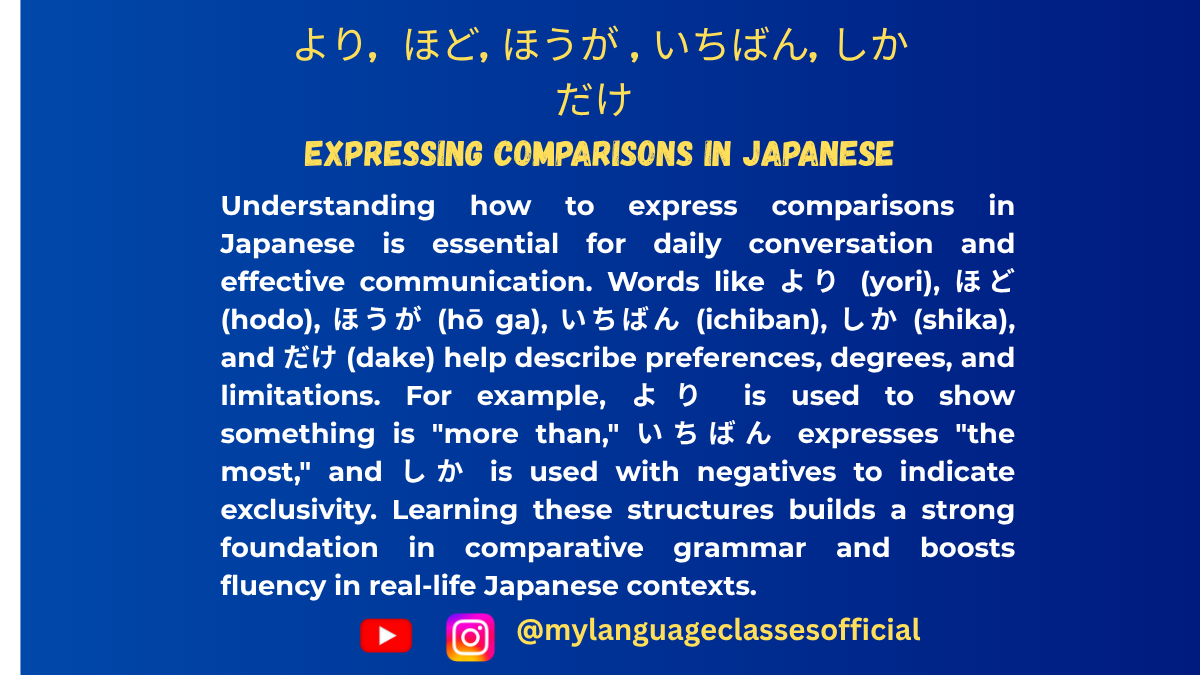
Mastering Comparisons in Japanese より, ほど, ほうが, いちばん, しか, and だけ | My Language Classes
Expressing Comparisons in Japanese より, ほど, ほうが, いちばん, しか, and だけ
When learning Japanese, one of the most important concepts is mastering the art of comparisons. Whether you’re talking about how something is “better” or “more” than something else, or simply stating your preference, knowing how to compare effectively helps you express yourself clearly and confidently. In this post, we’ll cover some of the most essential comparison structures in Japanese: より (more than), ほど (more than / to the extent of), ほうが (preference), いちばん (the most), and dive into important distinctions such as より vs ほど and だけ vs しか.
1. より (More Than)
The particle より is used when comparing two items, indicating that one is more than the other. It’s the most straightforward way to show superiority or difference between two things.
Example:
- この映画はあの映画より面白いです。
Kono eiga wa ano eiga yori omoshiroi desu.
This movie is more interesting than that movie.
Here, より is used to compare the two movies, with the first one being more interesting than the second.
2. ほど (More Than / To the Extent of)
ほど is used to express a comparison where something is “more than” another thing, but with a focus on degree or extent. It’s often used when talking about how much more of something there is, especially in terms of actions or abilities.
Example:
- 彼は私ほど速く走れません。
Kare wa watashi hodo hayaku hashiremasen.
He can’t run as fast as I can.
Here, ほど is used to emphasize the difference in the degree of speed. It’s not just “more than” in quantity, but more in terms of ability or extent.
3. より vs ほど (Key Difference)
While both より and ほど can be translated as “more than,” the distinction lies in their nuance:
- より is used for simple comparisons, where one thing is greater or superior than another in a more straightforward sense.
- ほど is used when discussing the degree or extent of a comparison, often involving abilities, qualities, or actions. It can also suggest “to the extent that” or “as much as.”
Example:
- 彼は私より背が高いです。
Kare wa watashi yori se ga takai desu.
He is taller than I am.
(Simple comparison) - 彼は私ほど速く走れません。
Kare wa watashi hodo hayaku hashiremasen.
He can’t run as fast as I can.
(Degree of ability comparison)
4. ほうが (Preference)
The structure ほうが is used to express preference between two things, indicating that one thing is favored over the other.
Example:
- 日本の映画はアメリカの映画より面白いほうが好きです。
Nihon no eiga wa Amerika no eiga yori omoshiroi hō ga suki desu.
I prefer Japanese movies over American movies because they are more interesting.
In this sentence, ほうが emphasizes the preference for Japanese movies compared to American movies.
5. いちばん (The Most)
いちばん is used to indicate the highest degree of something, meaning “the most” or “the best.” It’s used when something stands out as the most in a particular category.
Example:
- 彼女はクラスでいちばんかわいいです。
Kanojo wa kurasu de ichiban kawaii desu.
She is the most beautiful in the class.
Here, いちばん is used to express that she is the top or number one in terms of beauty.
6. だけ (Only) vs しか (Only, but Negative)
Another pair worth noting in comparisons is だけ and しか. Both can be translated as “only,” but the way they are used is quite different.
- だけ is used to indicate a positive statement or simple limitation.Example:
- このレストランには寿司だけがあります。
Kono resutoran ni wa sushi dake ga arimasu.
This restaurant only has sushi.
- このレストランには寿司だけがあります。
- しか is used with a negative verb, indicating “only” but with the sense that there is nothing more than that (often implying something less than expected).Example:
- このレストランには寿司しかありません。
Kono resutoran ni wa sushi shika arimasen.
This restaurant only has sushi (and nothing else).
- このレストランには寿司しかありません。
Notice that with しか, a negative verb is required, while with だけ, the statement can be positive.
Tips for Mastering Comparisons
- Understand the Context: Pay attention to whether you’re making a straightforward comparison or discussing degrees of difference. This will help you choose between より and ほど.
- Practice with Real-Life Examples: Try comparing things you see around you. For example, compare two foods, two movies, or two places. This helps you internalize comparison structures.
- Use ほうが for Preferences: If you’re ever unsure about how to express a preference, use ほうが. It’s a simple way to show that you favor one thing over another.
- Avoid Overcomplicating Things: Don’t worry about using every comparison structure at once. Focus on mastering one at a time—start with より and いちばん, then gradually incorporate ほど and ほうが into your conversations.
- Listen to Native Speakers: Pay attention to how native speakers make comparisons. Listening to their natural flow will help you understand which structure to use in various situations.
Final Thoughts: Mastering Comparisons for Fluent Communication
Mastering comparisons in Japanese is a crucial step toward fluency. By understanding how to use より (more than), ほど (more than / to the extent of), ほうが (preference), and いちばん (the most), you’ll be able to express differences, preferences, and extremes with precision and confidence.
Remember that the key to becoming proficient in any aspect of a language is practice. The more you engage with these comparison structures in your speaking and writing, the more natural they will feel.
So, keep practicing, stay curious, and challenge yourself to use comparisons in your everyday conversations. With continued effort and attention to detail, you’ll be able to navigate the nuances of Japanese comparisons and speak like a native speaker in no time. Happy learning!
If you enjoyed this lesson, be sure to check out more posts like this on my blog at My Language Classes. Don’t forget to subscribe my YouTube channel and follow me on Instagram for the latest language learning tips and lessons. Leave a comment below to share your thoughts, or ask any questions you have about nouns.
Happy learning! 😊
- この映画はあの映画より面白いです。
-

Understanding ある vs いる Japanese Existence Verbs | My Language Classes
Japanese Existence Verbs: ある (Aru) vs いる (Iru)
In Japanese, one of the fundamental concepts is the idea of existence, or being. Just like in any language, expressing whether something exists or is present is crucial to communication. In Japanese, this is expressed using two key verbs: ある (aru) and いる (iru).
Though both words translate as “to be” or “to exist,” their usage depends on the type of subject you’re referring to. This difference can be tricky for learners, but once you grasp it, you’ll find yourself speaking more naturally in Japanese.
1. ある (Aru) — Used for Inanimate Objects or Abstract Concepts
The verb ある (aru) is used to express the existence of inanimate objects, things, places, or abstract concepts. If the subject is something that doesn’t have life (like a chair, book, or idea), ある is the correct verb to use.
Examples:
- 本がある。
(Hon ga aru)
“There is a book.” - 学校がある。
(Gakkou ga aru)
“There is a school.”
(Literally, “A school exists.”) - 問題がある。
(Mondai ga aru)
“There is a problem.”
(Literally, “A problem exists.”)
As you can see, ある applies to non-living things—whether they are physical objects, places, or even abstract ideas like problems or opportunities.
2. いる (Iru) — Used for Living Things
On the other hand, いる (iru) is used to indicate the existence of living things, such as people, animals, or any other beings that can move or have consciousness. This includes everything from pets to people to animals.
Examples:
- 犬がいる。
(Inu ga iru)
“There is a dog.”
(Literally, “A dog exists.”) - 先生がいる。
(Sensei ga iru)
“There is a teacher.”
(Literally, “A teacher exists.”) - 友達がいる。
(Tomodachi ga iru)
“I have friends.”
(Literally, “Friends exist.”)
The verb いる is also commonly used to refer to living things when you’re describing their existence in a particular place or context. It’s important to note that いる is for beings that can move, think, or live.
The Difference Between ある and いる
To put it simply:
- Use ある when talking about inanimate objects, things, or places.
- Use いる when talking about living things—people, animals, etc.
How to Make Sentences Negative: ない (Nai)
Just like with other verbs in Japanese, you can make sentences negative by adding ない (nai), which is the negative form of both ある and いる.
- ある becomes ない:
本がない。 (Hon ga nai) — “There is no book.” - いる becomes いない:
犬がいない。 (Inu ga inai) — “There is no dog.”
These negative forms are essential for talking about the absence of something or someone.
Other Uses of ある and いる
- Existence in the Past (だった / いた) Just like in English, we can also talk about past existence in Japanese. あった (atta) and いた (ita) are the past tense forms of ある and いる, respectively.
- 本があった。
(Hon ga atta)
“There was a book.” - 犬がいた。
(Inu ga ita)
“There was a dog.”
- 本があった。
- Describing Location Both ある and いる are also used when talking about the location of things or people. The particles に (ni) or で (de) are typically used to indicate where the subject exists.
- 机の上に本がある。
(Tsukue no ue ni hon ga aru)
“There is a book on the desk.” - 公園に犬がいる。
(Kouen ni inu ga iru)
“There is a dog in the park.”
- 机の上に本がある。
A Helpful Trick to Remember
A simple trick to remember the difference between ある and いる is to think of the phrase “Life is moving.”
- いる for living things = I for I (living being, me, you, animals).
- ある for inanimate things = A for A object.
This small mnemonic can help keep the two verbs straight as you practice!
Conclusion
Understanding ある (aru) and いる (iru) is an essential part of learning Japanese, as it helps you express existence in various contexts. Whether you’re talking about inanimate objects, people, animals, or abstract concepts, knowing when to use each verb will make your Japanese sound more fluent and natural.
If you’re new to learning Japanese, start practicing these verbs with simple sentences and gradually increase complexity. With a little practice, expressing existence will become second nature to you!
If you enjoyed this lesson, be sure to check out more posts like this on my blog at My Language Classes. Don’t forget to subscribe my YouTube channel and follow me on Instagram for the latest language learning tips and lessons. Leave a comment below to share your thoughts, or ask any questions you have about nouns.
Happy learning! 😊
- 本がある。

